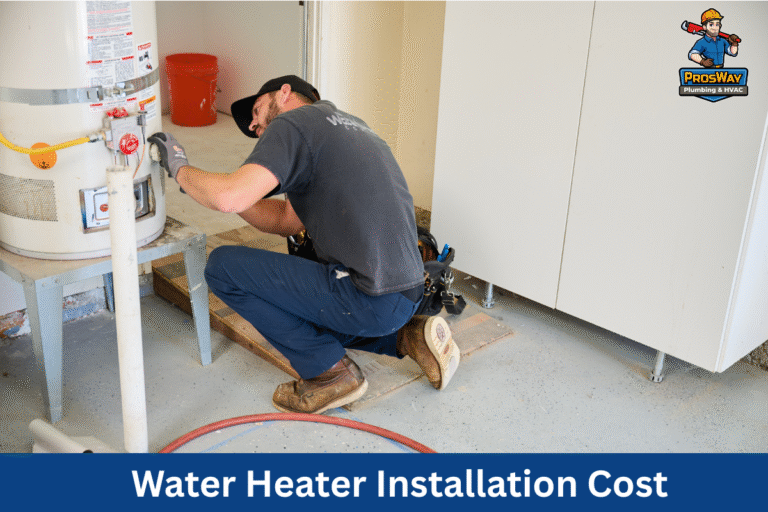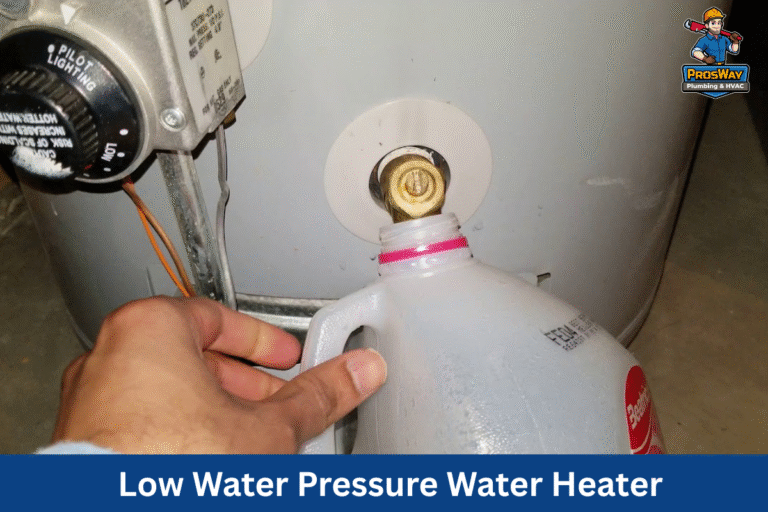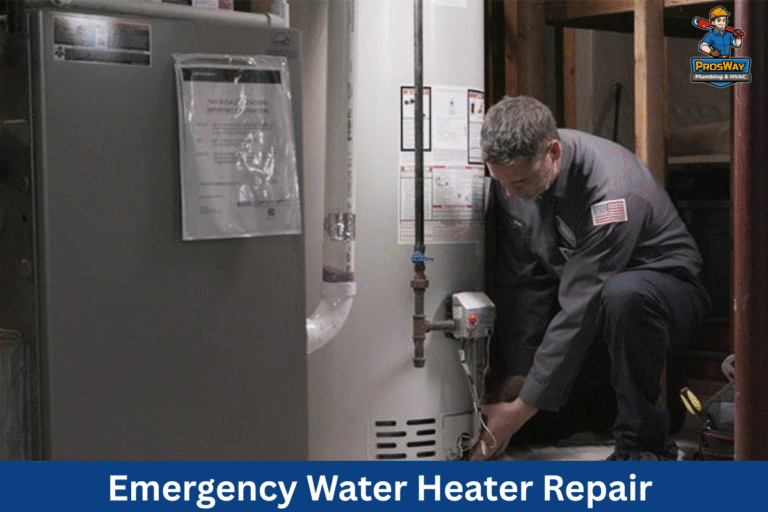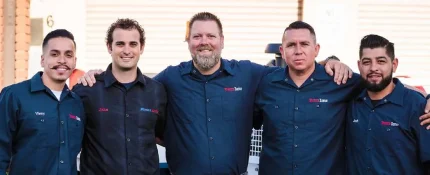In Northern New Jersey, many homeowners consider DIY sewer line repairs to save money, but is it worth it? Clogs and corrosion in cast iron pipes can cause serious issues. While DIY methods using tools and chemical cleaners may seem affordable.
This article breaks down the financial risks, safety concerns, and repair complexities of DIY sewer work. You’ll also learn when it’s smarter to call licensed professionals like ProsWay Plumbing & HVAC to ensure the job gets done right.
What Are the Financial Risks of DIY Sewer Repairs?

When it comes to repairing a sewer line on your own, the financial implications play a major role. The first question to ask is whether the cost savings justify the risks. In most cases, DIY repairs promise savings on professional service fees.
However, material costs for items like replacement pipes and tools can add up quickly. Professional plumbers have access to industry-grade equipment and might negotiate lower prices for materials.
Comparing DIY Material Costs Versus Professional Service Fees
Directly comparing costs, DIY material purchases often include overheads such as buying a drill, renting a backhoe, or even investing in trenchless sewer inspection tools.
For example, a new cast iron pipe or replacement pipe liner might cost you around $100–$300 per foot. On the other hand, professional services in our area might charge a premium.
But they also guarantee reliable workmanship and follow local building codes, reducing the risk of future failures. Numerous studies have shown that DIY efforts can reduce up-front expenses by 20–30%.
According to a study by the Journal of Plumbing Engineering (2018), homeowners are attempting DIY sewer repairs. They encountered a 25% increase in overall spending due to mistakes that later required professional intervention.
Where Do Hidden Costs Come In With DIY Projects?
Many DIY projects do not show hidden expenses until problems arise. Expenses often overlooked include the cost of renting heavy machinery.
Purchasing protective gear and the potential need for additional materials if initial repairs fail. Another hidden cost is time. Homeowners may spend countless hours troubleshooting.
Also, regulatory fines may occur if work is not performed according to building codes. In some cases, mistakes lead to water damage or even add thousands of dollars in unexpected expenses.
When Do Long-Term Savings Turn Into Long-Term Costs?
In theory, fixing the problem yourself could lead to long-term savings if the repair is done correctly. However, if the repair fails, a homeowner might end up facing Sewer Line Replacement costs, which are significantly higher.
Professional repairs often include warranties and account for trenchless sewer repair alternatives that ensure long-lasting results. In contrast, a DIY repair lacking proper diagnostic tools may result in incomplete repairs.
This cycle of ineffective fixes and additional costs outweighs any initial savings. A peer-reviewed study in the Journal of Home Maintenance (2020) found that 30% of DIY sewer repairs required a professional redo within the first two years.
What Should You Know Before Starting a DIY Sewer Line Repair?
If you decide to proceed with a DIY sewer line repair, careful planning and execution are essential. This section outlines the step-by-step process of repair.
It ensures that every important stage is understood and addressed. Each step is critical in ensuring your sewer repair is done properly and prevents future issues like sewer backup or corrosion in cast iron pipes.
Initial Preparations for a DIY Sewer Line Fix
The first step involves proper preparation. Begin by identifying the exact location of the clog or the broken sewer line, using a sewer video inspection if possible.
Safety gear such as gloves, goggles, and a dust mask must be worn at all times to guard against exposure to hazardous materials and gases emanating from the sewer.
Additionally, barriers and warning signs should be set up around the excavation site to keep family members and neighbors safe. Gather all necessary tools, pipes, sealant, drain cleaner, and even a backhoe if your repair area is extensive.
Check local building code and permit requirements to avoid regulatory issues later. Finally, have a contingency plan in case the repair escalates and requires professional intervention.
How Can You Diagnose the Problem Correctly?
Correctly identifying the problem is crucial. Many issues can mimic each other: a clog caused by debris might appear similar to a cracked pipe.
Use a combination of visual inspections and diagnostic tools. A sewer line inspection camera can reveal physical damage like cracks in cast iron or corrosion signs.
Assess the severity of the clog using water pressure tests and consider whether chemical drain cleaners might be a temporary fix. DIY diagnosis also involves checking for any signs of structural damage in the surrounding area.
Local experts suggest that even if a problem appears minor, it should be confirmed by a professional if you doubt the diagnosis, as misdiagnosis can lead to further damage.
Essential Tools and Materials for DIY Sewer Line Repair
Having the correct tools can prevent many mistakes. Each tool must be used according to the manufacturer’s instructions. Essential items include:
- Sewer Inspection Camera: Enables thorough examination behind walls and underground.
- Heavy-Duty Shovel and Pickaxe: Required for accurate excavation and trenching.
- Replacement Pipes and Fittings: Ensure you have the correct cast iron or PVC pipes that match your current system.
- Sealant and Epoxy: Specific to sewer repair, these help create watertight connections.
- Chemical Drain Cleaners: Use cautiously to remove clogs, but avoid over-reliance as they may cause pipe damage.
For instance, when using a drill for pipe connections, ensure the correct bit is attached to prevent stripping screws.
Watch this video: How to properly DIY a drain line.
Where Do You Begin With the Actual Repair Work?
Now that preparations and assessments have been made, carefully execute the repair. Start by excavating around the affected area with precision. When replacing a leaking section, remove the damaged segment completely and measure carefully.
Use pipe bursting or trenchless repair methods if the situation allows, as these innovative techniques reduce the need for extensive digging. For joints, ensure you apply the proper amount of sealant and check for proper alignment.
Consistent testing during connection ensures that the new section will integrate seamlessly. Always double-check that the slope and alignment meet proper requirements before finalizing the repair.
Post-Repair Testing and Area Restoration
Once the repair is complete, run a series of water tests to verify that no leaks exist. Walk through each section of the repaired line with a sewer camera to ensure there are no unseen issues.
Clean up the excavation site thoroughly, ensuring that you restore any disturbed areas to their original condition. Confirm that all safety hazards have been eliminated and that the repair meets the expectations set forth by local codes.
What Common Mistakes Do Homeowners Make With Sewer Repairs?
Even with extensive preparation, many homeowners encounter common pitfalls in DIY sewer line repair. These mistakes can arise from a lack of experience and misinterpretation of the actual problem.
Understanding these pitfalls and how to avoid them can be the difference between a lasting repair. And a recurring sewer line issue that can lead to emergency calls and additional expenses.
Why Is Misdiagnosing the Problem So Risky?
A common mistake is misdiagnosis. Homeowners often confuse physical damage with a temporary clog caused by debris. Failing to accurately identify the problem may lead you to apply the wrong solution.
Such as utilizing chemical drain cleaners on a structurally compromised cast iron pipe, which can worsen corrosion. Accurately identifying whether the issue is a solid blockage or a broken pipe.
An infiltration issue requires diagnostic tools. Without proper diagnosis, any fix is temporary and may eventually cause a complete backup or further water infiltration.
Incorrect Pipe Material Selection and Connection
Another frequent error is choosing the wrong replacement materials. The type of pipe, cast iron, PVC, or even steel, plays a significant role in successful repairs.
Each material requires specific connection methods and compatible sealants. Incorrect pipe material selection might result in poor drainage, chemical incompatibility.
Misaligned connections often lead to leaks, causing water damage and mold growth. It is vital to match the pipe material accurately and ensure all connections are secure and tested for leaks before finalizing.
How Can Excavation Mistakes Cause Bigger Problems?
Excavation is a crucial part of DIY sewer line repairs. Inadequate trench depth or uneven digging can harm the surrounding soil structure. And disrupt the natural slope required for proper sewage flow.
Mistakes in excavation may lead to complications. Such as insufficient clearance for new pipes or damaging nearby utility lines. Over-excavation, on the other hand, might cause excessive settling.
Or even collapse of the trench walls, posing severe safety risks. Often, homeowners underestimate the physical demand of precise trenching required for a successful sewer line repair.
Key Takeaways
- Misdiagnosing the sewer problem often leads to ineffective or worsening repairs.
- Proper material selection and secure pipe connections are essential to avoid leaks.
- Accurate and safe excavation is critical, as errors can result in structural damage.
- Maintaining the correct slope and alignment ensures proper drainage and prevents future clogs.
- Modern trenchless repair alternatives offer less disruptive yet durable solutions.
When Is It Time to Call a Sewer Repair Professional?

Not every sewer line problem is suited for a DIY solution. Some issues are simply too complex or hazardous for a homeowner to manage independently.
Recognizing when professional help is needed is critical to protecting your home and ensuring the long-term functionality of your sewer system.
What Signs Show the Damage Is Beyond DIY?
Indicators that your problem may exceed your DIY skills. It includes frequent backups, severe clogs that do not respond to chemical drain cleaners, and physical signs of deterioration.
If you notice persistent foul odors, water pooling in unusual areas, or visible damage from old cast iron pipes. These symptoms imply that the sewer line may require a more comprehensive professional repair.
Additionally, if multiple areas of your home are affected simultaneously, this might suggest systemic damage that goes beyond a simple blockage.
The Advantages of Hiring Licensed Plumbing Professionals
Hiring a licensed professional offers several key benefits. Professionals bring years of experience, specialized tools, and diagnostic equipment that can pinpoint the exact issue quickly.
They work by local building codes and obtain necessary permits, reducing the risk of fines. Moreover, licensed professionals offer warranties on their work.
They ensure that if the repair fails, you are not left with additional costs. Their expertise minimizes the risk of recurring issues and provides peace of mind.
How Do Warranties and Guarantees Help You?
One of the most compelling reasons to hire a professional is the guarantee of their work. Reputable companies offer warranties on repairs, which cover unforeseen issues.
These guarantees provide assurance that if the repair fails or if new problems emerge, the responsibility lies with the contractor. This peace of mind can be invaluable.
Especially for major repairs that cost thousands of dollars. With warranties in place, you are protected against the risk of additional costly procedures, making the overall investment more secure.
Key Takeaways
- Persistent issues and visible pipe deterioration indicate that professional intervention is necessary.
- Licensed professionals use advanced diagnostic tools to ensure a precise repair.
- Benefits of trenchless methods include reduced property damage and quicker restoration.
- Warranty and guarantees from professionals provide significant assurance.
- An accurate, professional sewer line assessment is vital for complex damage.
Why Consider DIY for Sewer Line Repairs at All?

Deciding whether to repair your sewer line yourself or hire a professional is a balancing act between potential cost savings and the risk of further damage.
While DIY repairs might appear economically attractive. The potential pitfalls and long-term consequences can outweigh the benefits. Knowing the pros and cons is key to making an informed decision.
Potential Cost Savings as a Primary Motivator for DIY
Many homeowners are drawn to DIY repairs because of the promise of saving money on labor costs. With careful planning and resourcefulness, you might reduce upfront expenses by 20–30%.
Eliminating the need to pay for expensive professional services is appealing, particularly if you have a limited budget. However, any initial savings might be quickly eroded by the cost of mistakes.
Additional materials or eventual professional intervention if the repair fails. While the idea of a lower bill is attractive, the hidden costs associated with DIY methods must be considered.
What Should You Know About Your Skill Level?
Before embarking on a DIY sewer repair, it is essential to realistically evaluate your skills and experience. Even seemingly simple repairs require attention to detail and familiarity with local plumbing codes and repair techniques.
If you have limited experience, minor mistakes can quickly turn into major issues. Such as improper pipe alignment or inadequate sealing, leading to leaks and water damage.
It is important to be honest about your ability. And to weigh your personal time investment against the potential risks and costs of a failed repair.
How Can DIY Work Affect Your Home’s Value?
Finally, consider how a DIY repair may affect your home’s value. Poorly executed repairs can become a red flag to future home buyers. Affecting appraisal values and possibly leading to a negative perception of property maintenance.
In some cases, the need for professional remediation due to faulty DIY work could become a point of contention during a home sale. A well-done repair by a licensed professional typically preserves your home’s long-term value.
Frequently Asked Questions
What are the financial implications of DIY sewer line repair?
DIY sewer line repair may offer upfront savings on labor costs, but hidden expenses such as additional materials, potential damage, and extended project times can quickly increase overall costs. Homeowners often find that professional repairs, which include warranties, provide better long-term value.
How do I know if my sewer line problem is too complex for DIY repair?
Signs that your sewer line issue is beyond DIY include frequent backups, persistent foul odors, visible deterioration of pipes, and recurring clogs. If diagnostic tools like sewer cameras reveal extensive damage or misalignment, it is best to consult with a professional.
What safety risks are associated with DIY sewer repairs?
DIY sewer repairs expose you to hazardous sewer gases, toxic bacteria, and potential physical injuries from heavy tools and excavation equipment. Without proper protective gear and professional techniques, these risks can lead to serious health issues or additional property damage.
Are there any benefits to using trenchless sewer repair methods?
Yes, trenchless repair methods offer several benefits, including minimal disruption to landscaping, faster repair times, and reduced labor costs. These methods preserve your property’s appearance and are preferred by professionals for complex sewer line issues.
How can professional repairs protect the value of my home?
Professional sewer repairs adhere to local building codes and industry standards, ensuring secure, long-lasting repairs. Detailed documentation and warranties also reassure potential buyers, thereby preserving or enhancing your home’s value over time.
Final Thoughts
DIY projects can lead to misdiagnosis and potential safety hazards that ultimately cost more in the long term. When you factor in the value of your time, the cost of mistakes, and the need for specialized tools protects your property and health. For residents in Northern New Jersey seeking reliable solutions to sewer problems, a professional approach such as that provided by ProsWay Plumbing & HVAC is often the smarter choice.
What’s the Next Step for Your Sewer Line Fix? Call ProsWay
If you’re unsure whether to tackle it yourself or call in the pros, don’t risk costly mistakes. Let ProsWay Plumbing & HVAC handle your sewer line repair with safety and long-lasting results. Call us now at (862) 260-5870 or Book Online for a professional sewer inspection.









